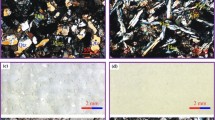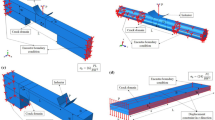Abstract
The boundary and loading conditions in many dynamic fracture test methods are frequently not well defined and, therefore, introduce a degree of uncertainty in the modeling of the experiment to extract the dynamic fracture resistance for a rapidly propagating crack. A new dynamic fracture test method is presented that overcomes many of these difficulties. In this test, a precracked, three-point bend specimen is loaded by a transmitter bar that is impacted by a striker bar fired from a gas gun. Different levels of energy can be imparted to the specimen by varying the speed and length of the striker to induce different crack growth rates in the material. The specimen is instrumented with a crack ladder gage, crack-opening displacement gage and strain gages to develop requisite data to determine toughness. Typical data for AISI 4340 steel specimen are presented. A simple quasi-dynamic analysis model for deducing the fracture toughness for a running crack from these data is presented, and the results are compared with independent measurements.
Similar content being viewed by others
References
Kanninen, M.F. andPopelar, C.H., Advanced Fracture Mechanics, Oxford University Press, New York (1985).
Couque, H., Leung, C.P., andHudak, S.J. Jr., “Effect of Planar Size and Dynamic Loading Rate on Initiation and Propagation Toughness of a Moderate-toughness Steel,”Eng. Fract. Mech.,47,249–267 (1994).
Zehnder, A. andRosakis, A.J., “Dynamic Fracture Initiation and Propagation in 4340 Steel Under Impact Loading,”Int. J. Fract.,43,271–285 (1990).
van Elst, H.C., “The Evaluation of the Resistance Against Crack Extension by Instrumented High Velocity Impact on 3-Points Bend (Drop Weight Tear Test Like) Specimens in Particular of Linepipe Steel in the Ductile Range Using Gasgun Facilities,”Advances in Fracture Research,2,ed.,D. Francois,Pergamon Press,New York,1059–1072 (1981).
Rittel, D., Maigre, H., andBui, H.D., “A New Method for Dynamic Fracture Toughness Testing,”Scripta Metall. Mat.,26,1593–1598 (1992).
Yokoyama, T., “Determination of Dynamic Fracture-initiation Toughness Using a Novel Impact Bend Test Procedure,”J. Press. Vessel Tech.,115,389–397 (1993).
Popelar, C.H., Walker, J.D., Anderson, C.E., Jr., Johnson, G.R., and Beissel, S.R., “Penetrator Case Fracture Predictive Technology: Volume I—Dynamic Fracture Mechanics Methodology,” Final Report, AFRL-MN-EG-TR-1999-7054, Air Force Research Laboratory (1999).
Tada, H., Paris, P.C., andIrwin, G.R., The Stress Analysis of Cracks Handbook, 2nd ed., Paris Production, St. Louis, MO, 2.16–2.17 (1985).
Freund, L.B., Dynamic Fracture Mechanics, Cambridge University Press, Cambridge (1990).
Author information
Authors and Affiliations
Rights and permissions
About this article
Cite this article
Popelar, C.H., Anderson, C.E. & Nagy, A. An experimental method for determining dynamic fracture toughness. Experimental Mechanics 40, 401–407 (2000). https://doi.org/10.1007/BF02326486
Received:
Revised:
Issue Date:
DOI: https://doi.org/10.1007/BF02326486




